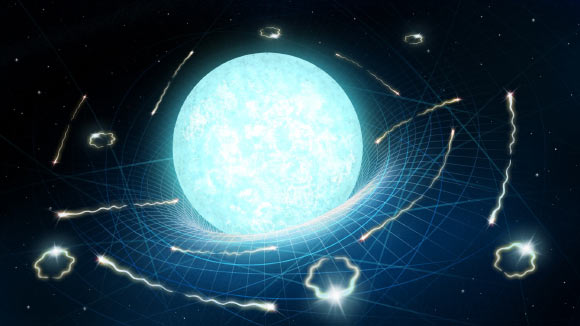In a 2023 paper, Professor Heino Falcke and his colleagues at Radboud University showed that not only black holes, but also all other objects in the Universe can ‘evaporate’ via a process akin to Hawking radiation. After that publication, the authors received many questions about how long the process would take. In a new study, they calculated that the end of the Universe is about 1078 years away, if only Hawking-like radiation is taken into account. This is the time it takes for white dwarfs — the most persistent celestial bodies — to decay via Hawking-like radiation. Previous studies, which did not take this effect into account, put the lifetime of white dwarfs at 101100 years.
An artist’s impression of a neutron star that is ‘evaporating’ slowly via Hawking-like radiation. Image credit: Daniëlle Futselaar / Artsource.nl.
“So the ultimate end of the Universe comes much sooner than expected, but fortunately it still takes a very long time,” Professor Falcke said.
In 1975, physicist Stephen Hawking postulated that, contrary to the theory of relativity, particles and radiation could escape from a black hole.
At the edge of a black hole, two temporary particles can form, and before they merge, one particle is sucked into the black hole and the other particle escapes.
One of the consequences of Hawking radiation is that a black hole very slowly decays into particles and radiation.
This contradicts Albert Einstein’s theory of relativity, which says that black holes can only grow.
Professor Falcke and co-authors calculated that the process of Hawking radiation theoretically also applies to other objects with a gravitational field.
The calculations further showed that the ‘evaporation time’ of an object depends only on its density.
To the researchers’ surprise, neutron stars and stellar black holes take the same amount of time to decay: 1067 years.
This was unexpected because black holes have a stronger gravitational field, which should cause them to ‘evaporate’ faster.
“But black holes have no surface,” said Dr. Michael Wondrak, a postdoctoral researcher at Radboud University.
“They reabsorb some of their own radiation which inhibits the process.”
“Because we were at it anyway, we also calculated how long it takes for the Moon and a human to evaporate via Hawking-like radiation: 1090 years,” the authors said.
“Of course, there are other processes that may cause humans and the Moon to disappear faster than calculated.”
“The research is an exciting collaboration of different disciplines and that combining astrophysics, quantum physics and mathematics leads to new insights,” said Radboud University’s Professor Walter van Suijlekom.
“By asking these kinds of questions and looking at extreme cases, we want to better understand the theory, and perhaps one day, we unravel the mystery of Hawking radiation.”
The new paper will be published in the Journal of Cosmology and Astroparticle Physics.
_____
Heino Falcke et al. 2025. An upper limit to the lifetime of stellar remnants from gravitational pair production. JCAP, in press; arXiv: 2410.14734
